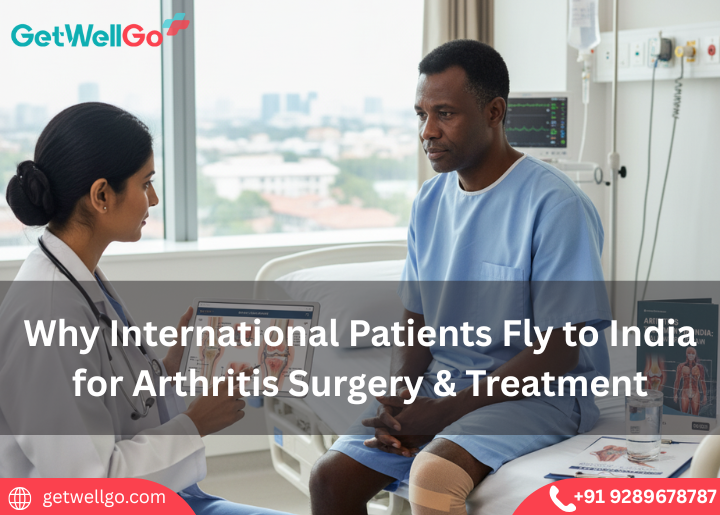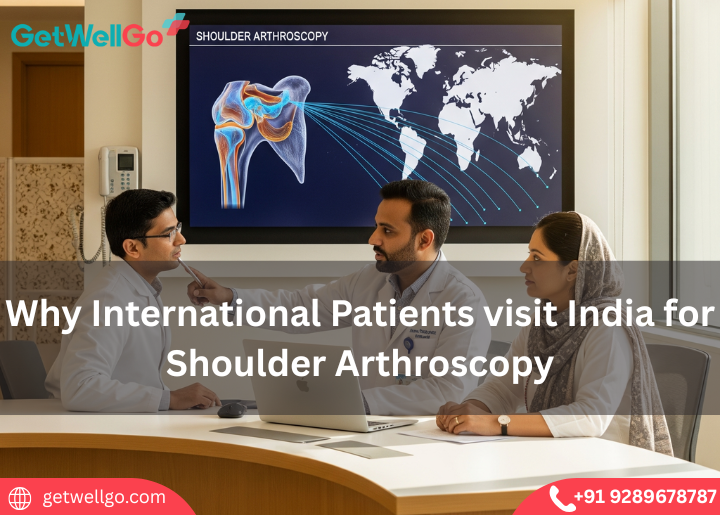
How International Patients Find Relief from Myopathies in India
GetWellGo helps international patients access advanced treatment for myopathies in India, ensuring expert care, comfort, and faster recovery abroad.
Read MoreFind top hospitals in India for benign bone tumor treatment with GetWellGo. Expert care, advanced tech & personalized support for international patients.
.png)
Category
OrthopedicPublished By
GetWellGo TeamUpdated on
13-Aug-2025Benign bone tumors occur as non-cancerous enlargements in the bone that tend to develop at a slow rate and do not metastasize to other organs of the body. Treatment will vary depending upon the type of tumor, its size/ location, symptoms, and age of the patient. The objectives are directed to symptom relief, the prevention of complications (such as fracture or deformity), and the maintenance of the functionality.
Curettage:
Radiofrequency Ablation (RFA):
Surgical Removal
Physical Rehabilitation
Rehabilitation through post treatment physiotherapy to regain body movement, muscle strength and joints.
Recurrence & Follow-Up
Artemis was founded in 2007 and is NABH- and JCI-accredited with a total of approximately 550 to 600 beds spread over a modern (~ 9 ac) campus. It has special departments such as Orthopaedics and Oncology and a special Artemis Cancer centre that provides 360 degree facilities in cancer treatment including musculo-skeletal cancer (soft tissue and bone tumors). Examples of brain tumors-benign or malign-the Artemis team will use a multimodal approach to diagnosis and treatment with medical oncologists and surgical teams, the use of nuclear medicine, pathology, and rehab services, frequently using tumor boards to provide individual care and treatment strategies. With the support of the latest imaging (3T MRI, PET-CT, gamma cameras), interventional radiology, radiation oncology (IGRT, brachytherapy), nuclear medicine.
Medanta - the Medicity is a super-specialty hospital that is built on 43-acre land in Gurgaon, Haryana in 2009 by Dr. Naresh Trehan. It acts as the hub of greater tertiary care of the group. The hospital boasts in the field of orthopaedics and musculoskeletal practices providing services between a minimal invasive surgery and complicated joint procedures. Its Cancer Institute offers a multidisciplinary approach to medical practice that involves medical, surgical and radiation oncology. It also provides sophisticated technologies such as CyberKnife, Tomotherapy, IGRT, VMAT and PET-CT imaging; all are very pertinent in precise diagnosis and control of tumor. Medanta employs the use of tumor board discussions which involve meetings between oncologists, surgeons, radiologists, pathologists, and other experts to formulate localized treatment programs of the patients.
FMRI is located in Sector 44, near HUDA City Centre metro station and was set up about 2010 with 300 bed (or 310-330, according to other sources) and 15 operating theaters and more than 100 ICU beds. It is located in an 11-acre campus that is carefully planned in line with convenience to the patients. FMRI also has state of the art centers in the fields of Oncology (medical, surgical, radiation), Orthopaedics (joint replacement and sport medicine), Neurosciences, Transplants, Hemato-oncology etc. Fortis cancer institute (FCI) provides comprehensive cancer management such as chemotherapy, radiation, immunotherapy and other supportive services like rehabilitation, psychological counselling, and nutrition. It has such highlights as MR Linac, Gamma Knife Esprit, MRIs (3T), advanced Interventional Radiology, PET-CT imaging, and state-of-the-art OT complexes.
Max Saket is a big NABH and JCI-certified multispecialty hospital that has more than 530 beds and 267 ICU beds. It has state of the art medical infrastructure such as 3.5T MRI, 256 slice CT angiography, first of its kind BrainSUITE intra-operative MRI in Asia and state of the art oncology and orthopaedic units. The hospital also provides all the orthopaedic-related services, inclusive of joint replacement, trauma, and spine, surgical, medical, and radiation oncology. It engages in musculoskeletal oncology where giant cell limb salvage surgeries, even including radial ulna operations have been reported to have been carried out by their specialists.
Benign bone tumor treatment may have a very broad range in terms of cost since it culminates into various medical, hospital and patient related costs. This is a breakdown like this:
Kind of Noncancerous Tumor
They show different types (e.g., osteoid osteoma, enchondroma, giant cell tumor) which need different surgery or non-surgery procedures which may hike the prices.
Size & Location
Tumors or tumors close to joints, nerves, or important structures generally have more complex removal, specific implants, or extensive recovery time.
Growth Rate & Stage
Some previously harmless, but aggressive tumors (e.g., giant cell tumors) may require larger, more intense treatments and follow-up.
Imaging Tests
X-ray, CT, MRI, PET-CT, bone scans - the cost varies according to how many and of what kind of scans are required.
Biopsy
The addition of procedure and pathology costs arises with needle or open biopsy.
Special Tests
There are additional expenses when immunohistochemistry or molecular testing (when necessary) is used to test it.
Observation / Monitoring
In slow growing, asymptomatic tumors- least cost (mostly periodical imaging).
Minimally Invasive Processes
The radiofrequency ablation or cryoablation might involve the expensive technology and skills.
Surgical Approach
Hospital Type
The prices of corporate/private hospitals are usually higher than the government or charitable organizations.
Surgeon’s Expertise
Orthopedic oncology surgeons that are highly experienced might come with high professional fee.
Hospital Location
Treatment cost can be higher in metropolitan cities than in the smaller towns.
Physiotherapy
Compulsory to recovery and post-operative mobility.
Rehab & Dominators
The cost may be increased with walkers, braces or limb supports.
Medications
Answer: pain treatment, antibiotic or bone-strength meds such as bisphosphonates.
Length of stay
The simple curettage may require 1 or 2 days; more extensive reconstruction may take 5 and 10 days or more.
ICU Requirement
Unusual with benign tumors, but in case it is necessary, extreme cost increment.
Recurrence Risk
Other benign tumors (e.g. giant cell tumors) require intensive follow up and imaging, which are more cost-adding in the long-term.
Additional Surgeries
In case there is recurrent occurrence, repeat operations may increase the overall expenditure of treatment.
Removal surgery of benign bone tumor is carried out when there are symptoms due to the presence of a non-malignant bone tumor, the weakening of the bone, the impairment of functionality, or when it exhibits an aggressive nature. This is done to cure the disease by total removal of the tumor and returning bone strength and avoid recurrence without losing too much normal bone and function.
When Surgery should be Recommended?
Curettage
What it involves: Scraping of the tumor out of the bone with a curette.
Along with:
Wide / En Bloc Resection
Minimally Invasive Ablation
Preoperative Assessment
Procedure
Postoperative Care
The factors influencing the acquisition of low-cost treatment of a benign bone tumor are based on the problem of medical necessity and cost-saving without adverse consequences. These are the major reasons:
GetWellGo is a facilitation healthcare founded to assist international patients in availing treatment in India. The major services are:
GetWellGo is regarded as a leading supplier of healthcare services. We help our foreign clients choose the best treatment locations that suit their needs both financially and medically.
We offer:

GetWellGo helps international patients access advanced treatment for myopathies in India, ensuring expert care, comfort, and faster recovery abroad.
Read More
From joint pain to recovery, GetWellGo connects international patients with advanced bursitis treatment in India for lasting relief and mobility.
Read More
GetWellGo helps international patients access India’s leading arthritis surgery & treatment with expert doctors, modern care & affordable options.
Read More
Travel to India for minimally invasive spine surgery with GetWellGo: faster healing, reduced pain, and world-class care for international patients.
Read More
GetWellGo connects international patients to advanced peripheral nerve surgery in India, ensuring expert treatment, safety, and holistic recovery.
Read More
Failed Back Syndrome treatment in India with GetWelGo. Access advanced care, expert surgeons & affordable solutions. New hope awaits international patients.
Read More
Foraminotomy in India made easy with GetWellGo. International patients get expert spine specialists & trusted care to relieve back pain effectively.
Read More
GetWellGo connects international patients to trusted Osteoporosis Stem Cell Therapy in India, combining expert care with cost-efective solutions.
Read More
GetWellGo helps global patients access top doctors in India for shoulder arthroscopy—advanced techniques, cost savings & trusted healthcare.
Read More
Robotic knee replacement in India helps global patients regain mobility with precision surgery, faster recovery, reduced pain, and long-lasting joint function at affordable costs.
Read More
Planning Arthroscopy Surgery in India? GetWellGo shares 5 key facts every international patient should know for safe, affordable, and effective treatment.
Read More.png)
Discover why international patients choose India for disc replacement surgery, with expert spine surgeons, advanced technology, affordable costs, and world-class rehabilitation care.
Read MoreFill the form below to get in touch with our experts.
Please fill in your details below and our experts will get back to you.